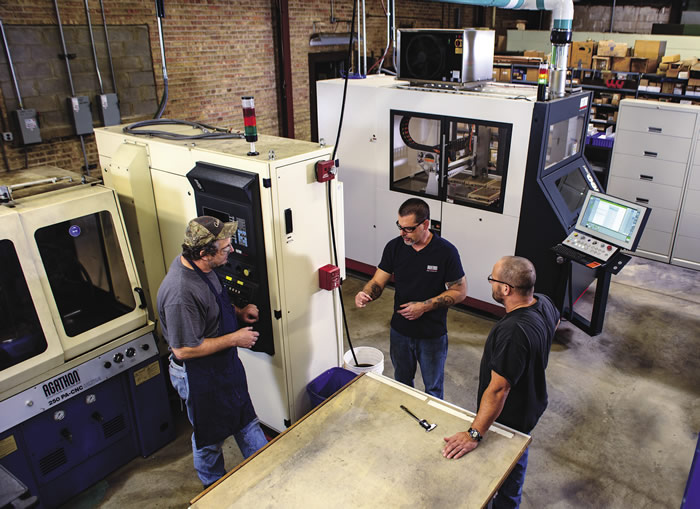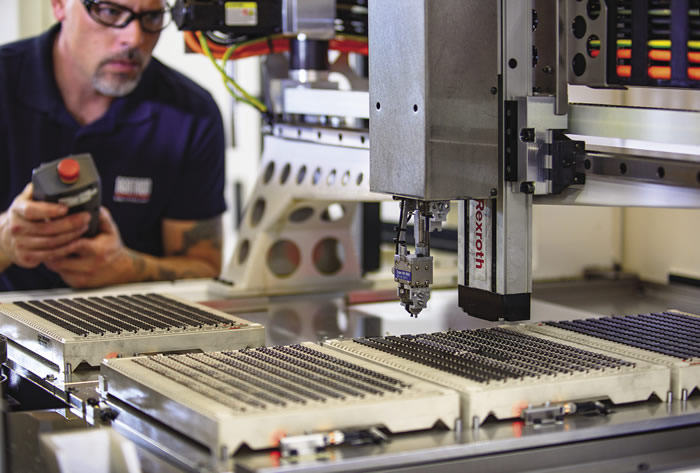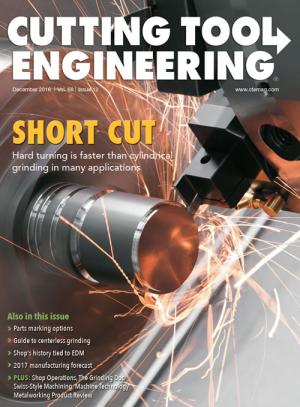
END USER: lllinois Carbide Tool Co. Inc., (800) 323-2414, www.crobaltusa.com, www.brakedrumtool.com.
SOLUTION PROVIDER: Agathon Machine Tools Inc., (203) 730-8741, www.agathon.com.
CHALLENGE: Keep up with increasing production demands for carbide brake lathe inserts.
SOLUTION: A 4-axis grinding machine that enables lights-out production.

More production sometimes requires fewer machines. As orders for its carbide brake lathe inserts increased at least 20 percent during the last 18 months, Illinois Carbide Tool Co. Inc. transitioned from six grinding machines with obsolete technology to a newer CNC grinder and a brand-new CNC grinder, said Mike Mini, company owner and manager.
The Waukegan, Ill., manufacturer has two operating divisions: Brake Drum Tool Co., which produces inserts, tool bodies and cutting tools for the automotive industry, such as cylinder boring tools; and Crobalt, which manufactures a high-cobalt cast alloy used in metalcutting and woodworking tools and wear parts.
Mini explained that automotive repair shops apply the brake lathe inserts to resurface brake drums and rotors. However, the six semiautomatic grinders the company was using to make these inserts were built in the 1980s and were unable to keep up with increasing production demands because they were slow and would consistently break down. Once out of service, the troubleshooting and the search for repair parts would commence. Because of their older technology, it could take up to 3 or 4 weeks to get a grinder back up and running. “There were usually only about four out of the six running at a time,” he said.


Left to right: Mark Wawiorka, operator and technician; Chuck Best, CNC operator and technician; and Dan Quinn, operations manager; discuss setup and operation of Illinois Carbide Tool’s two Agathon grinding machines: a 250 PA-CNC Ultra (foreground) and a Leo Peri. Image courtesy Presage Professional Inc.

Mini added that the person with the most experience operating these grinders could repair about 85 percent of the problems, but obtaining parts was a challenge and not an effective use of company resources. The inserts in these grinders had to be manually loaded and unloaded by the operator into the machine’s single magazine. The operator had to manually dress the grinding wheels, check that a machine was operating properly so an insert’s IC tolerance of ±0.001" (0.0254mm) was being held while ensuring that the center screw hole was concentric to the insert’s triangular shape.
“One person would be hard-pressed to keep three or four machines running at a time,” Mini said.
“When you have older technology and you’re having problems with a grinder,” he said, “you hate to spend the money for these repairs because you’re throwing good money after bad. You start looking for solutions in the latest grinding technology.”
One of Crobalt’s long-term cutting tool customers primarily runs grinding machines from Agathon Machine Tools Inc., Bethel, Conn. When this customer offered Illinois Carbide Tool a used Agathon Model 250 PA-CNC Ultra grinder in 2014, the company purchased it.
“It was a major initial step in enabling us to get our production up to where it needed to be at a critical time,” Mini said.
As insert demand continued to increase, the company purchased a new Leo Peri 4-axis grinding center from Agathon earlier this year. According to Mini, the new machine is ideal for producing the company’s carbide inserts, which do not require K-lands or special features, eliminating the need for a 5-axis grinder. “A gantry loads and unloads inserts, enabling the one-shift facility to run lights-out production,” Mini said.


Chuck Best, CNC operator and technician at Illinois Carbide Tool, sets parameters for the Leo Peri grinder’s pick-and-place robot. Image courtesy Presage Professional Inc.

The grinder interfaces with up to six standard pallets and these pallets can be purchased for specific sizes of inserts. Complete automation of the periphery grinding process by the new grinder achieves insert quality that was previously unobtainable by the older technology, according to Mini. “We currently are not producing on Sundays, but we certainly could if the need would arise.”
The new Agathon grinder has totally replaced the semiautomatic grinders. Improvement in the quality and precision of the insert’s IC grind means rejects are virtually eliminated, according to Mini. Should a problem occur, the machine will automatically cease grinding and go into a standby mode.
“After only a few weeks of initial orientation on the new grinder, our experienced CNC operator, Chuck Best, was able to have the grinder running at maximum efficiency, and lights-out operation is now standard operating procedure for four or five nights out of the workweek,” Mini said.
The new Agathon Leo Peri grinder has changed the entire production dynamic at Illinois Carbide Tool and its divisions, Mini said. “In addition to carbide indexable insert grinding, we are utilizing the new Agathon to grind our cast alloy woodworking inserts for our Crobalt customers. This is something we could not have done on the older-technology grinders.”
He added that the company continues to explore the Leo Peri’s capabilities.
“We did retain two of the older-technology grinders as emergency backup [machines], and the others are in storage for possible sale, or we may find someone who wants to purchase one for parts,” Mini said.
Related Glossary Terms
- boring
boring
Enlarging a hole that already has been drilled or cored. Generally, it is an operation of truing the previously drilled hole with a single-point, lathe-type tool. Boring is essentially internal turning, in that usually a single-point cutting tool forms the internal shape. Some tools are available with two cutting edges to balance cutting forces.
- chuck
chuck
Workholding device that affixes to a mill, lathe or drill-press spindle. It holds a tool or workpiece by one end, allowing it to be rotated. May also be fitted to the machine table to hold a workpiece. Two or more adjustable jaws actually hold the tool or part. May be actuated manually, pneumatically, hydraulically or electrically. See collet.
- computer numerical control ( CNC)
computer numerical control ( CNC)
Microprocessor-based controller dedicated to a machine tool that permits the creation or modification of parts. Programmed numerical control activates the machine’s servos and spindle drives and controls the various machining operations. See DNC, direct numerical control; NC, numerical control.
- grinding
grinding
Machining operation in which material is removed from the workpiece by a powered abrasive wheel, stone, belt, paste, sheet, compound, slurry, etc. Takes various forms: surface grinding (creates flat and/or squared surfaces); cylindrical grinding (for external cylindrical and tapered shapes, fillets, undercuts, etc.); centerless grinding; chamfering; thread and form grinding; tool and cutter grinding; offhand grinding; lapping and polishing (grinding with extremely fine grits to create ultrasmooth surfaces); honing; and disc grinding.
- grinding machine
grinding machine
Powers a grinding wheel or other abrasive tool for the purpose of removing metal and finishing workpieces to close tolerances. Provides smooth, square, parallel and accurate workpiece surfaces. When ultrasmooth surfaces and finishes on the order of microns are required, lapping and honing machines (precision grinders that run abrasives with extremely fine, uniform grits) are used. In its “finishing” role, the grinder is perhaps the most widely used machine tool. Various styles are available: bench and pedestal grinders for sharpening lathe bits and drills; surface grinders for producing square, parallel, smooth and accurate parts; cylindrical and centerless grinders; center-hole grinders; form grinders; facemill and endmill grinders; gear-cutting grinders; jig grinders; abrasive belt (backstand, swing-frame, belt-roll) grinders; tool and cutter grinders for sharpening and resharpening cutting tools; carbide grinders; hand-held die grinders; and abrasive cutoff saws.
- indexable insert
indexable insert
Replaceable tool that clamps into a tool body, drill, mill or other cutter body designed to accommodate inserts. Most inserts are made of cemented carbide. Often they are coated with a hard material. Other insert materials are ceramic, cermet, polycrystalline cubic boron nitride and polycrystalline diamond. The insert is used until dull, then indexed, or turned, to expose a fresh cutting edge. When the entire insert is dull, it is usually discarded. Some inserts can be resharpened.
- inscribed circle ( IC)
inscribed circle ( IC)
Imaginary circle that touches all sides of an insert. Used to establish size. Measurements are in fractions of an inch and describe the diameter of the circle.
- lathe
lathe
Turning machine capable of sawing, milling, grinding, gear-cutting, drilling, reaming, boring, threading, facing, chamfering, grooving, knurling, spinning, parting, necking, taper-cutting, and cam- and eccentric-cutting, as well as step- and straight-turning. Comes in a variety of forms, ranging from manual to semiautomatic to fully automatic, with major types being engine lathes, turning and contouring lathes, turret lathes and numerical-control lathes. The engine lathe consists of a headstock and spindle, tailstock, bed, carriage (complete with apron) and cross slides. Features include gear- (speed) and feed-selector levers, toolpost, compound rest, lead screw and reversing lead screw, threading dial and rapid-traverse lever. Special lathe types include through-the-spindle, camshaft and crankshaft, brake drum and rotor, spinning and gun-barrel machines. Toolroom and bench lathes are used for precision work; the former for tool-and-die work and similar tasks, the latter for small workpieces (instruments, watches), normally without a power feed. Models are typically designated according to their “swing,” or the largest-diameter workpiece that can be rotated; bed length, or the distance between centers; and horsepower generated. See turning machine.
- metalcutting ( material cutting)
metalcutting ( material cutting)
Any machining process used to part metal or other material or give a workpiece a new configuration. Conventionally applies to machining operations in which a cutting tool mechanically removes material in the form of chips; applies to any process in which metal or material is removed to create new shapes. See metalforming.
- pick-and-place robot
pick-and-place robot
Simple robot or piece of hard automation that is capable of the simple actions of picking an object from a fixed point and placing the object at another fixed point.
- tolerance
tolerance
Minimum and maximum amount a workpiece dimension is allowed to vary from a set standard and still be acceptable.


